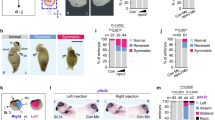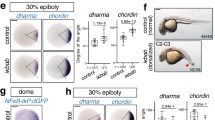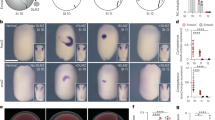Abstract
In groundbreaking experiments, Hans Spemann demonstrated that the dorsal part of the amphibian embryo can generate a well-proportioned tadpole, and that a small group of dorsal cells, the ‘organizer’, can induce a complete and well-proportioned twinned axis when transplanted into a host embryo. Key to organizer function is the localized secretion of inhibitors of bone morphogenetic protein (BMP), which defines a graded BMP activation profile. Although the central proteins involved in shaping this gradient are well characterized, their integrated function, and in particular how pattern scales with size, is not understood. Here we present evidence that in Xenopus, the BMP activity gradient is defined by a ‘shuttling-based’ mechanism, whereby the BMP ligands are translocated ventrally through their association with the BMP inhibitor Chordin. This shuttling, with feedback repression of the BMP ligand Admp, offers a quantitative explanation to Spemann’s observations, and accounts naturally for the scaling of embryo pattern with its size.
This is a preview of subscription content, access via your institution
Access options
Subscribe to this journal
Receive 51 print issues and online access
$199.00 per year
only $3.90 per issue
Buy this article
- Purchase on Springer Link
- Instant access to full article PDF
Prices may be subject to local taxes which are calculated during checkout




Similar content being viewed by others

References
Waddington, C. H. Canalization of development and the inheritance of acquired characters. Nature 150, 563–565 (1942)
Kirschner, M. & Gerhart, J. Evolvability. Proc. Natl Acad. Sci. USA 95, 8420–8427 (1998)
De Robertis, E. M. Spemann’s organizer and self-regulation in amphibian embryos. Nature Rev. Mol. Cell Biol. 7, 296–302 (2006)
Spemann, H. Embryonic Development and Induction (Yale Univ. Press, New Haven, 1938)
Spemann, H. & Mangold, H. Induction of embryonic primordia by implantation of organizers from a different species. Roux’s Arch. Entw. Mech. 100, 599–638 (1924)
Harland, R. M. Neural induction in Xenopus . Curr. Opin. Genet. Dev. 4, 543–549 (1994)
Cooke, J. Scale of body pattern adjusts to available cell number in amphibian embryos. Nature 290, 775–778 (1981)
Lowe, C. J. et al. Dorsoventral patterning in hemichordates: insights into early chordate evolution. PLoS Biol. 4, e291 (2006)
Marques, G. et al. Production of a DPP activity gradient in the early Drosophila embryo through the opposing actions of the SOG and TLD proteins. Cell 91, 417–426 (1997)
Ferguson, E. L. Conservation of dorsal–ventral patterning in arthropods and chordates. Curr. Opin. Genet. Dev. 6, 424–431 (1996)
De Robertis, E. M. & Kuroda, H. Dorsal-ventral patterning and neural induction in Xenopus embryos. Annu. Rev. Cell Dev. Biol. 20, 285–308 (2004)
Francois, V. & Bier, E. Xenopus chordin and Drosophila short gastrulation genes encode homologous proteins functioning in dorsal–ventral axis formation. Cell 80, 19–20 (1995)
Sasai, Y. et al. Xenopus chordin: a novel dorsalizing factor activated by organizer-specific homeobox genes. Cell 79, 779–790 (1994)
Sasai, Y., Lu, B., Steinbeisser, H. & De Robertis, E. M. Regulation of neural induction by the Chd and Bmp-4 antagonistic patterning signals in Xenopus . Nature 376, 333–336 (1995)
Khokha, M. K., Yeh, J., Grammer, T. C. & Harland, R. M. Depletion of three BMP antagonists from Spemann’s organizer leads to a catastrophic loss of dorsal structures. Dev. Cell 8, 401–411 (2005)
Ross, J. J. et al. Twisted gastrulation is a conserved extracellular BMP antagonist. Nature 410, 479–483 (2001)
Oelgeschlager, M., Larrain, J., Geissert, D. & De Robertis, E. M. The evolutionarily conserved BMP-binding protein Twisted gastrulation promotes BMP signalling. Nature 405, 757–763 (2000)
Chang, C. et al. Twisted gastrulation can function as a BMP antagonist. Nature 410, 483–487 (2001)
Larrain, J. et al. Proteolytic cleavage of Chordin as a switch for the dual activities of Twisted gastrulation in BMP signaling. Development 128, 4439–4447 (2001)
Goodman, S. A. et al. BMP1-related metalloproteinases promote the development of ventral mesoderm in early Xenopus embryos. Dev. Biol. 195, 144–157 (1998)
Piccolo, S. et al. Cleavage of Chordin by Xolloid metalloprotease suggests a role for proteolytic processing in the regulation of Spemann organizer activity. Cell 91, 407–416 (1997)
Dosch, R. & Niehrs, C. Requirement for anti-dorsalizing morphogenetic protein in organizer patterning. Mech. Dev. 90, 195–203 (2000)
Moos, M., Wang, S. & Krinks, M. Anti-dorsalizing morphogenetic protein is a novel TGF-beta homolog expressed in the Spemann organizer. Development 121, 4293–4301 (1995)
Reversade, B. & De Robertis, E. M. Regulation of ADMP and BMP2/4/7 at opposite embryonic poles generates a self-regulating morphogenetic field. Cell 123, 1147–1160 (2005)
Decotto, E. & Ferguson, E. L. A positive role for Short gastrulation in modulating BMP signaling during dorsoventral patterning in the Drosophila embryo. Development 128, 3831–3841 (2001)
Eldar, A. et al. Robustness of the BMP morphogen gradient in Drosophila embryonic patterning. Nature 419, 304–308 (2002)
Umulis, D. M., Serpe, M., O’Connor, M. B. & Othmer, H. G. Robust, bistable patterning of the dorsal surface of the Drosophila embryo. Proc. Natl Acad. Sci. USA 103, 11613–11618 (2006)
Mizutani, C. M. et al. Formation of the BMP activity gradient in the Drosophila embryo. Dev. Cell 8, 915–924 (2005)
Meinhardt, H. & Roth, S. Developmental biology: sharp peaks from shallow sources. Nature 419, 261–262 (2002)
Shimmi, O., Umulis, D., Othmer, H. & O’Connor, M. B. Facilitated transport of a Dpp/Scw heterodimer by Sog/Tsg leads to robust patterning of the Drosophila blastoderm embryo. Cell 120, 873–886 (2005)
Wang, Y. C. & Ferguson, E. L. Spatial bistability of Dpp-receptor interactions during Drosophila dorsal–ventral patterning. Nature 434, 229–234 (2005)
van der Zee, M., Stockhammer, O., von Levetzow, C., da Fonseca, R. N. & Roth, S. Sog/Chordin is required for ventral-to-dorsal Dpp/BMP transport and head formation in a short germ insect. Proc. Natl Acad. Sci. USA 103, 16307–16312 (2006)
O’Connor, M. B., Umulis, D., Othmer, H. G. & Blair, S. S. Shaping BMP morphogen gradients in the Drosophila embryo and pupal wing. Development 133, 183–193 (2006)
Eldar, A., Shilo, B. Z. & Barkai, N. Elucidating mechanisms underlying robustness of morphogen gradients. Curr. Opin. Genet. Dev. 14, 435–439 (2004)
Oelgeschlager, M., Kuroda, H., Reversade, B. & De Robertis, E. M. Chordin is required for the Spemann organizer transplantation phenomenon in Xenopus embryos. Dev. Cell 4, 219–230 (2003)
Reversade, B., Kuroda, H., Lee, H., Mays, A. & De Robertis, E. M. Depletion of Bmp2, Bmp4, Bmp7 and Spemann organizer signals induces massive brain formation in Xenopus embryos. Development 132, 3381–3392 (2005)
Ohkawara, B., Iemura, S.-I., ten Dijke, P. & Ueno, N. Action range of BMP is defined by its N-terminal basic amino acid core. Curr. Biol. 12, 205–209 (2002)
Lander, A. D., Nie, Q. & Wan, F. Y. Do morphogen gradients arise by diffusion? Dev. Cell 2, 785–796 (2002)
Lee, H. X., Ambrosio, A. L., Reversade, B. & De Robertis, E. M. Embryonic dorsal–ventral signaling: secreted frizzled-related proteins as inhibitors of tolloid proteinases. Cell 124, 147–159 (2006)
Jones, C. M., Armes, N. & Smith, J. C. Signalling by TGF-β family members: short-range effects of Xnr-2 and BMP-4 contrast with the long-range effects of activin. Curr. Biol. 6, 1468–1475 (1996)
Lemaire, P., Garrett, N. & Gurdon, J. B. Expression cloning of Siamois, a Xenopus homeobox gene expressed in dorsal–vegetal cells of blastulae and able to induce a complete secondary axis. Cell 81, 85–94 (1995)
Marom, K., Levy, V., Pillemer, G. & Fainsod, A. Temporal analysis of the early BMP functions identifies distinct anti-organizer and mesoderm patterning phases. Dev. Biol. 282, 442–454 (2005)
Fagotto, F., Guger, K. & Gumbiner, B. Induction of the primary dorsalizing center in Xenopus by the Wnt/GSK/beta-catenin signaling pathway, but not by Vg1, Activin or Noggin. Development 124, 453–460 (1997)
Collavin, L. & Kirschner, M. W. The secreted Frizzled-related protein Sizzled functions as a negative feedback regulator of extreme ventral mesoderm. Development 130, 805–816 (2003)
Zernicka-Goetz, M. et al. An indelible lineage marker for Xenopus using a mutated green fluorescent protein. Development 122, 3719–3724 (1996)
Meinhardt, H. Primary body axes of vertebrates: generation of a near-cartesian coordinate system and the role of Spemann-type organizer. Dev. Dyn. 235, 2907–2919 (2006)
Fainsod, A., Steinbeisser, H. & De Robertis, E. M. On the function of BMP-4 in patterning the marginal zone of the Xenopus embryo. EMBO J. 13, 5015–5025 (1994)
Salic, A. N., Kroll, K. L., Evans, L. M. & Kirschner, M. W. Sizzled: a secreted Xwnt8 antagonist expressed in the ventral marginal zone of Xenopus embryos. Development 124, 4739–4748 (1997)
Sopory, S., Nelsen, S. M., Degnin, C., Wong, C. & Christian, J. L. Regulation of bone morphogenetic protein-4 activity by sequence elements within the prodomain. J. Biol. Chem. 281, 34021–34031 (2006)
Acknowledgements
We thank J. Christian for the BMP4 constructs, and the members of our groups for discussions and help with the experiments. This work was supported by Minerva, the Israel Science Foundation and the Hellen and Martin Kimmel award for innovative investigations to N.B. and a grant from the Israel Science Foundation and the Wolfson Family Chair in Genetics to A.F. B-Z.S. holds the Hilda and Cecil Lewis Professorial chair in Molecular Genetics.
Author information
Authors and Affiliations
Corresponding authors
Supplementary information
Supplementary Information
The Supplementary Information section contains the following: 1. Figure describing the Xenopus and Drosophila dorsoventral patterning network, and a schematic representation of the inhibition and shuttling mechanisms. 2. Details of the numerical screen. 3. Detailed list of parameters used to generate the figures in the main text. 4. Analytical treatment of the steady state of the shuttling model. 5. Analytical treatment of the general model. 6. Analysis of the effect of the mutual regulation of BMP ligands and Chordin. 7. Formalization of the system using dimensionless equations. 8. Numerical solution of an extended model for the dorsoventral patterning, including the BMP receptors and Tsg. 9. Discussion of the geometry of the model. (PDF 657 kb)
Rights and permissions
About this article
Cite this article
Ben-Zvi, D., Shilo, BZ., Fainsod, A. et al. Scaling of the BMP activation gradient in Xenopus embryos. Nature 453, 1205–1211 (2008). https://doi.org/10.1038/nature07059
Received:
Accepted:
Issue Date:
DOI: https://doi.org/10.1038/nature07059
This article is cited by
-
Highly conserved and extremely evolvable: BMP signalling in secondary axis patterning of Cnidaria and Bilateria
Development Genes and Evolution (2024)
-
Experimental duplication of bilaterian body axes in spider embryos: Holm’s organizer and self-regulation of embryonic fields
Development Genes and Evolution (2020)
-
Adapting machine-learning algorithms to design gene circuits
BMC Bioinformatics (2019)
-
Size flips symmetry switch
Nature Physics (2019)
-
Mouse embryo geometry drives formation of robust signaling gradients through receptor localization
Nature Communications (2019)
Comments
By submitting a comment you agree to abide by our Terms and Community Guidelines. If you find something abusive or that does not comply with our terms or guidelines please flag it as inappropriate.


